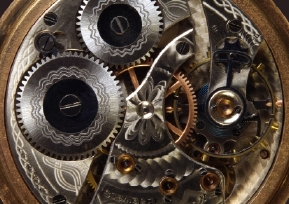|
The Evolution of WatchmakingWatchmaking started long before the advent of the cell phone as a timekeeping device. Americans relied on a wristwatch to get them to daily appointments on time. As the economy grew after World War II, many people owned a mass produced watch from such well-known American companies as Timex, Bulova and Elgin. Winding the wristwatch to store mechanical energy into its mechanism was a ritual that was practiced daily or weekly until the self-winding watch appeared on the scene. While modern people take a watch for granted, when the watch was invented in the 1500’s it was a marvel of engineering and craftsmanship. The earliest watches were actually small clocks that the town guard, also called the night watchman, wore around his neck or waist while making his appointed rounds. Just like aboard sailing vessels, in towns the 24-hour day was divided into watches and the term persists even today in naval and police operations. We assume that naming the timepiece as a watch derives from this early usage of portable clocks that were attached to the body of the night watchman.
The Role of Miniaturization
Remember that in the 1500’s clockmaking was still a relatively new endeavor. The earliest clocks were cumbersome devices that were frequently made by blacksmiths who had the technology for forging components for a clock. But it’s a long way from clumsy iron pieces to the intricate springs, wheels and levers needed for a miniature clock that was portable. While many early clockmakers arose from the ranks of blacksmiths, the watchmakers came from the guilds of locksmiths, goldsmiths and jewelers. Over time making watches evolved into a skilled trade. Master watchmakers were able to fabricate a complete watch without any assistance. They developed the skills needed to file, saw and fabricate watch parts out of brass and steel that were only millimeters in size completely by hand. Watchmakers and clockmakers eventually joined together in the clockmaking guild, differentiated only by the size of the product they worked on. During the sixteenth and seventeenth centuries, guilds dominated
European clock
and watch making. Guilds served to maintain high quality and a system of teaching the trade to apprentices; but at the same time the domination of the watchmakers by the guilds stifled innovation and competition. By the early 1600’s the role of the guilds declined.
Mass Production
Around the same period as the decline in the power of the guilds came an increased demand for watches in Europe. Watch production became an early assembly line business. Families specialized in the fabrication of watch components like springs, balance wheels, and plates in cottage industry shops. Watch mechanics fine tuned these components into finished watches. Switzerland became the leading center for watches with a large number of cottage shops producing watch components during the early 1700’s. Watchmaking also became an important industry in major cities throughout Europe including London, Nuremburg and Paris. The era of handcrafted watches lasted for 300 years, from the 1500’s through the 1800’s. From the late 1800’s onward, the watch industry was chiefly conducted in a factory environment with assembly line methods to meet the common demand for personal timepieces.
The Impact of Electronic WatchesThe manufacturing of traditional gear driven clocks and watches suffered serious decline when electronic timepieces were introduced into the marketplace in the 1960’s. These cheaper and easier to use watches which did not require periodic winding became the watch of choice for millions of working people. The watch was a necessity item and the throwaway society in general preferred not to take care of an expensive watch for daily use. The quartz watch came on the scene in the 1970’s. Consumers preferred the quartz watch to mechanical watches. Skilled watch mechanics weren’t needed to create or repair quartz watches. Instead, a fine watch was defined as a standard quartz movement that was ensconced in elegant case. When this quartz movement wears out, it is simply replaced rather than adjusted or repaired. The same disposable aspect that makes modern watches so popular fueled the resurgence of interest in fine mechanical watches during the late 1980’s. Status conscious individuals saw the more expensive and delicate mechanical watch as a symbol of prosperity. Today name brand watches are a status symbol. The role of the watchmaker in society has come full circle over the span of 500 years of watchmaking. The wealthy again perceive the value in owning a hand-made precision watch with a mechanical movement. Need more information?
|




